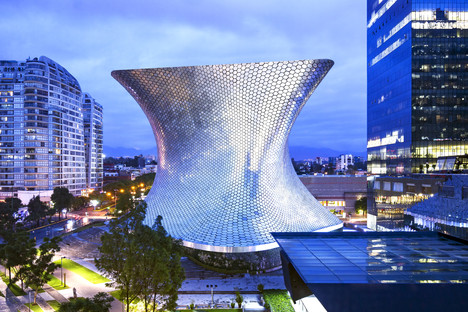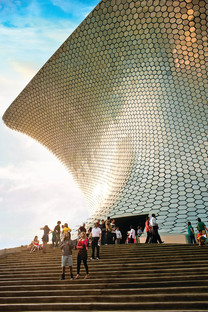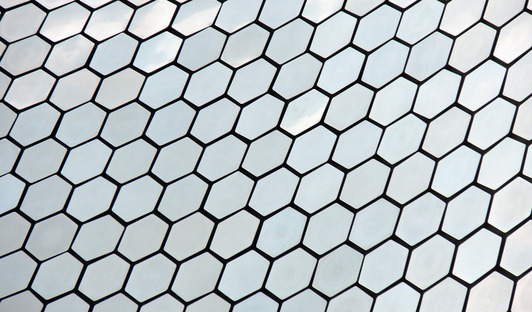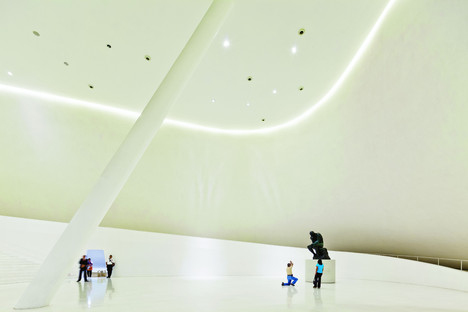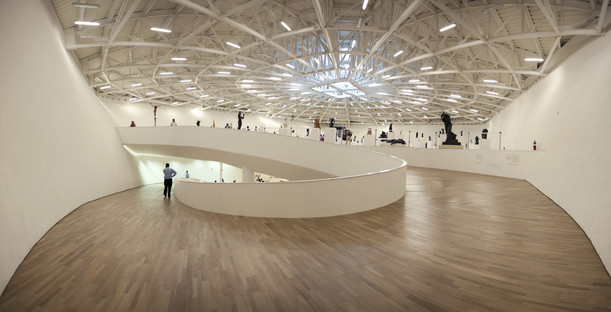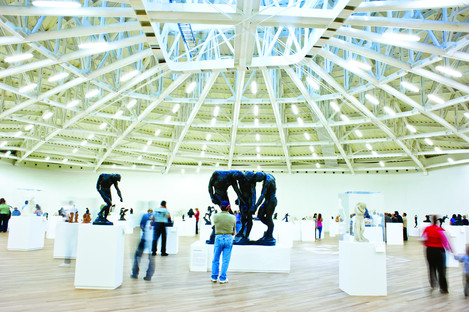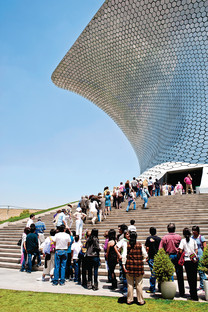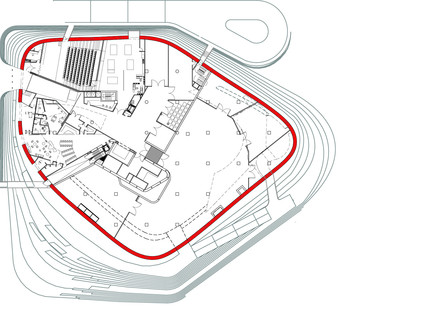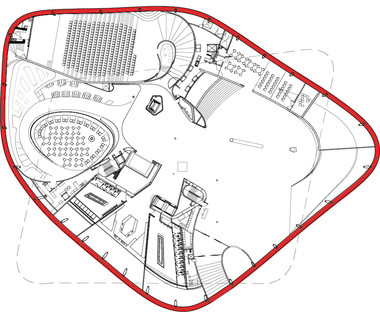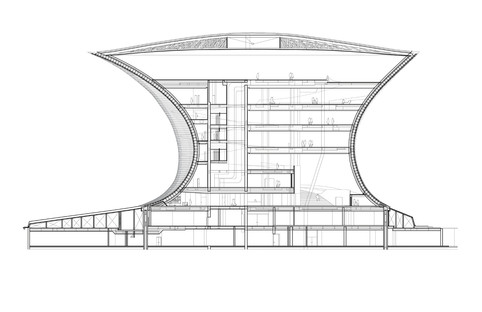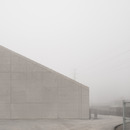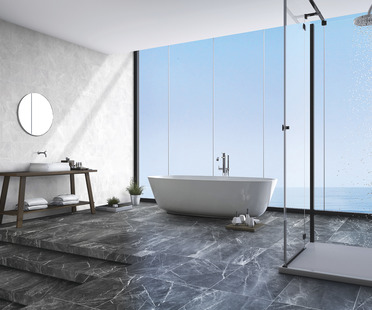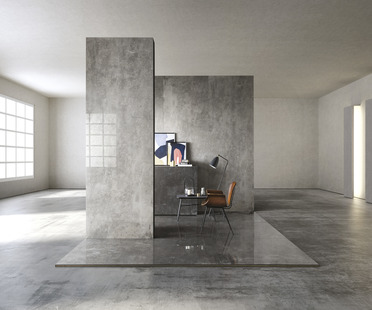28-07-2017
Curved façade with aluminium hexagons – Soumaya Museum in Mexico City
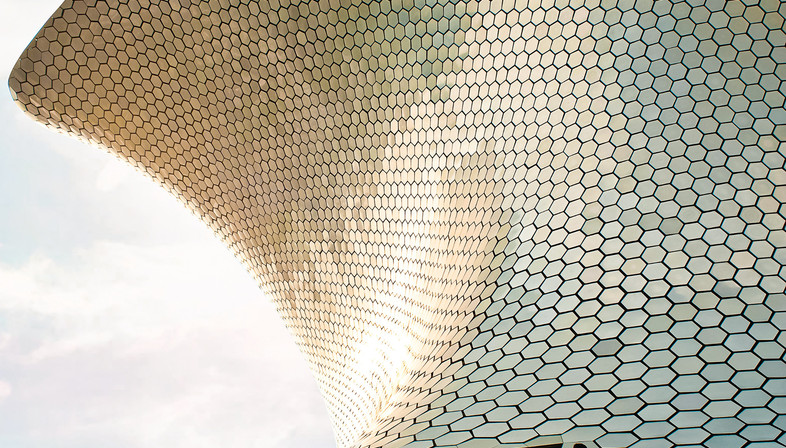 Mexico City’s Polanco district has a new museum with a unique shape on the scene of old and modern Mexican architecture; its sculptural form gives the neighbourhood a new identity, and its windowless façade covered with 16,000 hexagonal aluminium modules gives the whole area a unique mystical air, to the point that it has become a popular local attraction. The second most important collection of Rodin sculptures has found its perfect home in a museum that is itself a sculpture; Fernando Romero’s formal intuition has become reality thanks to the consulting services of Arup and Gehry Technologies, which took care of structural and façade requirements without diminishing any of the project’s strong semantic charge. The closed (windowless) façade which is not developed, that is, cannot be reduced to flat elements to be put together, imposed a choice that turned out to be successful, and its originality might also come in handy in architectural solutions for other projects. The base and its inner heart are made of concrete, supporting a second structure made of steel and bearing up the entire façade, which consists of a primary grid of bent tubes and a secondary grid supporting the tarred outer wall, on which four-armed supports are positioned to support 16,000 aluminium hexagons juxtaposed to form a continuous open mesh. The architect’s successful intuition is that rigidly joining together all the hexagons to create a sort of classic ventilated façade would have generated other problems, especially in the building’s form, which would certainly have broken up the façade more, making it less fluid in its formal elasticity. The top floor is dominated by a skylight, like a oecus recalling the pantheon in Rome, obtained not by eliminating the blocks at the top of a dome, but by building a steel roof like a “spoked wheel”, a form of construction that permits creation of a round opening, the perfect summit for a fluid, dynamic rising composition.
Mexico City’s Polanco district has a new museum with a unique shape on the scene of old and modern Mexican architecture; its sculptural form gives the neighbourhood a new identity, and its windowless façade covered with 16,000 hexagonal aluminium modules gives the whole area a unique mystical air, to the point that it has become a popular local attraction. The second most important collection of Rodin sculptures has found its perfect home in a museum that is itself a sculpture; Fernando Romero’s formal intuition has become reality thanks to the consulting services of Arup and Gehry Technologies, which took care of structural and façade requirements without diminishing any of the project’s strong semantic charge. The closed (windowless) façade which is not developed, that is, cannot be reduced to flat elements to be put together, imposed a choice that turned out to be successful, and its originality might also come in handy in architectural solutions for other projects. The base and its inner heart are made of concrete, supporting a second structure made of steel and bearing up the entire façade, which consists of a primary grid of bent tubes and a secondary grid supporting the tarred outer wall, on which four-armed supports are positioned to support 16,000 aluminium hexagons juxtaposed to form a continuous open mesh. The architect’s successful intuition is that rigidly joining together all the hexagons to create a sort of classic ventilated façade would have generated other problems, especially in the building’s form, which would certainly have broken up the façade more, making it less fluid in its formal elasticity. The top floor is dominated by a skylight, like a oecus recalling the pantheon in Rome, obtained not by eliminating the blocks at the top of a dome, but by building a steel roof like a “spoked wheel”, a form of construction that permits creation of a round opening, the perfect summit for a fluid, dynamic rising composition.Fabrizio Orsini
Project: Museo Soumaya
Client: Fundación Carlos Slim
Construction: 2011
Address: Lago Zurich # 245, Col. Ampliación Granada, Del. Miguel Hidalgo. México DF. C.P. 11320 rea: 16,000 m²
Architect: FR-EE Fernando Romero Enterprise
Consultants: Inpros, PC Constructores, Colinas de Buen, Swecomex, Dypro, Garza Maldonado y Asociados, Hubard Bourlon, Sitcom, Museo Soumaya / Alfonso Miranda, Gehry Technologies, Mier y Terán, Lighteam & Arquitectura de la Luz, Kone & Arsenio Rodríguez Consulting, Saad Acústica
Team: Fernando Romero y Mauricio Ceballos
with: Matthew Fineout, Sergio Rebelo, Omar Gerala Félix, Laura Domínguez, Herminio González, Ignacio Méndez, Ana Paula Herrera, Luis Ricardo García, Ana Medina, Mario Mora, Juan Pedro López, Guillermo Mena, Libia Castilla, Raúl García, Manuel Díaz, Alan Aurioles, Ana Gabriela Alcocer, Iván Ortiz, Tiago Pinto, Juan Andres López, Olga Gómez, Hugo Fernández, Kosuke Osawa, Francisco Javier de la Vega, David Hernández, Jorge Hernández, Joaquín Collado, Mariana Tafoya, Eduardo Benítez, Pedro Lechuga, Thorsten Englert, Luis Fuentes, Luis Flores, Rodolfo Rueda, Víctor Chávez, Max Betancourt, Wonne Ickxs, Dolores Robles-Martínez, Sappho Van Laer, Ophelie Chassin, Elena Haller, Abril Tobar, Diego Eumir Jasso, Albert Beele, Homero Yánez, Cynthia Meléndez, Hugo Vela, Susana Hernández Aparicio, Gerardo Galicia, Alberto Duran, Camilo Mendoza, Dafne Zvi Zaldívar, Cecilia Jiménez, Ángel Ortiz, Raúl Antonio Hernández, Alma Delfina Rosas, Wendy Guillen, Raúl Flores, Daniel Alejandro Farías, Jesús Monroy, Saúl Miguel Kelly, Iván Javier Avilés, Cesar Pérez.










